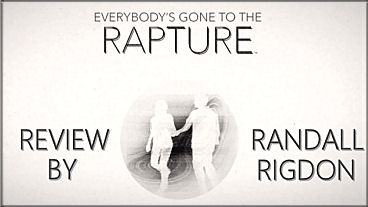
Everybody’s Gone To Rapture Review
There are glimpses of a storytelling breakthrough throughout the mostly static, but highly intriguing Everybody’s Gone to Rapture, but ultimately the whole thing feels like a failed experiment.







Genre: Point-And-Click Adventure
Release date: July 28, 2015
If you’re an adventure game enthusiast you’ve no doubt heard the term “walking simulator,” a label that’s been blanketed across the many actionless first-person games that have arisen across our digital download stores. Adventure gamers perhaps more easily discern the current indie trend as the Myst-clone reincarnated, taking a working formula of the past and manifesting it into something fresh and modern. If there were ever a game, however, that truly deserved the “walking simulator” reputation, The Chinese Room’s Dear Esther would have been that game, and spiritual successor Everybody’s Gone To Rapture pretty much follows in the same vein.
If you didn’t play Dear Esther or perhaps simply forgot, the sole functionality of its player interaction was walking forward from point A to B. By continuously holding down the forward key the player would walk across the shorelines and caverns of a beautifully-rendered island, while a minimalistic, interpretive story unfolded itself through the occasional poetic narration. Dear Esther had sentimental value for me, and in a lot of ways it captured everything great about interactive storytelling. It was short, simple, had a fantastic, engaging atmosphere, and told a moving story. It was everything it needed to be and that was pretty much all there was all to it.
When Sony announced they were publishing The Chinese Room’s next title, obviously it was expected that the stakes for the Dear Esther follow-up would be higher, especially considering the small-indie developer would now be working with a serious budget. With this in mind, Everybody’s Gone to Rapture delivers – it’s Dear Esther with a Hollywood budget. Everything is larger, the environment is enormous, the premise is huge, the technical prowess is boastful. This works in Rapture’s favor as much as it works against it.
The game world is gigantic and somewhat overwhelming in scope. Additionally, the graphical splendor of the environment is impressive, and probably pushed my PS4 harder than any game yet. An awkward contrast, however, immediately sets in when it becomes painfully apparent just how quaint and static the game world’s setting really is, and just how much of it you’ll need to just trod through aimlessly.
In a lot of ways, the small-town old-English countryside setting is exactly where Everybody’s Gone To Rapture deserves to be applauded. We live in a world where video games can take us anywhere we want to go and it’s refreshing to see a side of the post-apocalypse that you’d never expect to see. Furthermore, dropping the player into an empty British countryside where all of its citizens have gone missing is just a good premise in itself, and it’s especially good context for a Myst-styled adventure where exploring intriguing, isolated, uninhabited environments is completely to be expected. A huge part of why we love these games so much is because they provide us original, immersive settings, and Rapture gives us a good one.
What’s more, Rapture isn’t actually totally lifeless; it’s quite the opposite actually. I initially thought I would simply rummage through a big empty environment and figure out the story through obscure environmental cues, much as a Myst-styled adventure typically provides. Instead the player actually witnesses a very large casting of many, many characters through the very large, open-world setting, but not in actual true-to-life form. Instead, the player will come across countless “spirits,” or rather glowing auras of human figures, that appear randomly everywhere in the environment who then reenact moments prior to the happening in the countryside, with lots and lots of dialogue. Typically, the player movement speed will be slowed down enough during dialogues to make leaving the scene not worthwhile, but oftentimes the player can decide to walk past the scene entirely and simply move along.
This is ultimately where Everybody’s Gone To Rapture doesn’t quite work. Although the dialogue is extremely well-performed and the ghost sprites are a brilliant way to relay information without interrupting player exploration, there isn’t really much of anything going on in front of you. You’re looking at two glowing balls suspended in the air above an empty room or street-side which are engaged mid-conversation without providing a lot of context for what’s going on. While the dialogue does start to make more sense as you progress, it’s mostly just characterization, and it always seems that the characters manage to bounce around the subject-matter of their conversations just enough so everything always, annoyingly, remains enigmatic to the player.
This means you’re forced to stand around and listen to subjectless dialogue from faceless, indiscernible characters as you walk around in an environment that looks beautiful but, shockingly, lacks any real detail. The Chinese Room claimed Everybody’s Gone To Rapture would introduce more environmental interaction to the player, but obviously they were just being funny, as further opening already opened doors was the only way I saw to affect anything at all. Although there’s a lot of nice, beautifully-crafted scenery along the adventure, they’re few and far between, which means a lot of the time you’re just looking at an empty street or the inside of a cleanly decorated house that doesn’t look any different than the last five house you’ve looked in. Even Dear Esther had a number of tiny details hidden in the backgrounds of its environment, and Rapture is probably ten times its size in every sense.
Considering the environment is inordinately large and doesn’t really offer anything dynamic besides exploring its many empty crevices without any of sense of direction, it becomes obligatory to chase down the giant glowing aura that paints itself through the environment and leads you to next the piece of cryptic dialogue you’ve yet to find. Considering that Rapture entirely becomes about following the glowing line from one scene to the next, the adventure becomes inseparable from Dear Esther in the sense that you’re simply spectating a non-player-influenced story which unfolds as you simply walk through the scenery. This ultimately renders the open-world environment a mere illusion, as once again it’s a simple walk from point A to point B in an entirely linear fashion.
Everything noted in this review so far has been on game mechanics, and while there is a lot of wasted potential in that regard, a strong narrative experience could have compensated for this kind of bare-bones adventure. I will say there are many genuinely moving moments in this storytelling experiment where the performances of the voice actors are especially strong and emotional for a video game, even if you never really see anything acted out or ever have any idea of what’s going on or who’s who thanks to the facelessness of the glowing talking auras.
The big disappointment with the narrative content, however, is The Chinese Room’s choice to leave the material cryptic and abstract. There is a decent development between a reoccurring man and woman destined to solve the mystery of the town’s many missing inhabitants, and it becomes these characters whom we follow to the end of the story. There’s a lot of a build up and a lot of anticipation, a lot of which works extremely effectively and managed to keep me thoroughly engaged for most of the adventure. However, with a premise as strong as an entire countryside disappearing, it would have only made sense to satisfy the player’s whole reason for engagement by providing some concrete and substantial answers to the mystery at hand, especially considering that who you are is never established and why you’re the only one wandering around a desolate human-free environment is just as perplexingly left unanswered.
Instead, The Chinese Room chooses to remain uncompromisingly ambiguous and unclear, especially in its concluding moments. While an interpretive end made sense for the poetic nature of Dear Esther, it’s simply unfulfilling for the ambitious, building mystery of Rapture. To the very end, I felt the potential for a fuller explanation was just on the horizon. Instead, the ending left me with some quasi-pseudo-spiritual ramblings that didn’t fit anywhere in the narrative, yet still felt like the easiest way out. Sure, it all sounds nice and pleasing set to some pretty orchestral music, but there’s nothing of actual meaning or explanation, and that’s fairly disappointing when the entire game works on the player’s drive to search for answers.
There are glimpses of a storytelling breakthrough throughout the mostly static, but highly intriguing Everybody’s Gone to Rapture, but ultimately the whole thing feels like a failed experiment. There are worthy attempts to deliver information to players in new and exciting ways but the game is simply too ambitious for its own good and gives us something too small and too ambiguous to fulfill the initially promising beginnings. The Chinese Room would arguably benefit from clearly determining if it wants to make smaller, personal, more poetic games or suspensful adventures with larger-than-life mysteries. Such a lack of direction is reflected on the players, who will find themselves lost even after they’ve found their way through the entire adventure.
|
+ Original, beautifully rendered setting with lots of nice scenery
+ Strong vocal performances
– Lack of player interaction, very linear experience
– Unclear, unfulfilling, unmoving narrative
– Extremely static environment without enormous detail
|

|

Leave a Reply